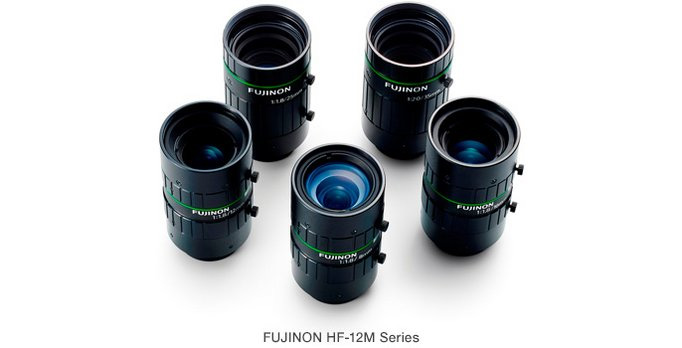Fujifilm Introduces FUJINON HF-12M Series Machine Vision Lenses
Fujifilm announced FUJINON HF-12M Series Machine Vision Lenses that feature cutting-edge optical technology and ultra clear resolution. The HF-12M series delivers even and edge-to-edge sharpness under versatile installation conditions. The world’s smallest* and lightest** body compatible with 2/3-inch sensors with 2.7µm pixel pitch***

FUJINON HF-12M Series Machine Vision Lenses
Photo by FUJIFILM Europe GmbH
In mid-June 2016 FUJIFILM Corporation will launch the FUJINON HF-12M series (hereinafter “HF-12M”) as a top-of-the-range machine vision lens for use in product inspections and measurements in production lines. The lenses are compatible with a 2/3-inch sensor with a 2.7 µm pixel pitch***. The HF-12M series is the world’s smallest* and lightest** weight machine vision lens that delivers an even edge-to-edge sharpness under a variety of installation conditions. HF-12M is available in five models of various focal lengths, allowing users to choose the optimum focal length and angle of view according to their usage.
At manufacturing facilities, a machine vision system is generally installed to capture and recognize images of the production lines, and automatically carry out positioning, measuring and inspecting materials and components. The demand for the machine vision system is projected to grow as requests for automation and streamlining work in production lines expands.
To respond to the current market demanding for more product efficiency and stricter quality management, machine vision systems also need to achieve higher image recognition accuracy and processing speed. This prompted the development of cameras with larger sensors, higher resolution and higher frame rates. The lenses, as the first point of the image information to a camera, must have even, edge-to-edge sharpness to facilitate recognition accuracy of the systems.
HF-12M is a series of prime lenses that produce ultra-sharpness with 2.7µm pixel pitch (equiv. to 8MP) in the whole frame area. HF-12M lenses maintain a high level of even sharpness at the center as well as around the edges, and mitigating resolution degradation that typically occurs when changing a working distance or aperture value. This enables the consistent delivery of high-resolution images, even under varying installation and shooting conditions at the manufacturing frontline. This feature named “4D*4 High Resolution” is a unique feature of the HF-12M. Thanks to the world’s smallest and lightest body measuring just φ33mm in external diameter for all the five models, the lenses can easily accommodate an installation environment with space constraints.
Fujifilm offers a wide range of lenses for the age of high resolution digital imaging, tapping into the optical technologies and precision processing and assembling technologies nurtured over many years. In the machine vision field with strong growth potential, Fujifilm is committed to addressing customer needs with its extensive lineup of lenses that deliver constant high resolution in greater installation conditions.
The new HF-12M series will be showcased from March 15-17, 2016 at the China (Shanghai) International Machine Vision Exhibition, which is one of the largest trade shows exhibiting machine vision systems and key components in China.
For more information, please visit http://www.fujifilm.eu/
* The smallest external diameter among MV lenses compatible with a 2/3-inch sensor and over 8MP with C mount. (as of March 15, 2016 according to Fujifilm data)
** The lightest weight among MV lenses compatible with a 2/3-inch sensor and over 8MP with C mount compared with models with same focal length (as of March 15, 2016 according to Fujifilm data)
*** Pixel pitch is an indicator of sensor’s image definition capability. The unit “µm” represents the distance between adjacent pixels. The smaller the number is (i.e. higher pixel density), the higher the image definition becomes.
*4 Two dimensions (plane) plus two additional dimensions of “working distance” and “aperture”
News Categories
- » NEWS HOME
- » Automation & Robotics
- » Industry 4.0
- » Material Handling
- » Sensors
- » Quality & Testing
- » Machine Vision
- » Laser & Optics
- » Metalworking
- » Motion Control & Drives
- » Hydraulics & Pneumatics
- » Process Industry
- » Renewable Energy
- » Agriculture
- » Home & Office Furniture
- » Environmental Tech

